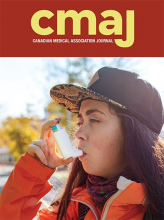Pressurized metered-dose (pMDI) inhalers are an important contributor to greenhouse gas emissions
Hydrofluorocarbon propellants in pMDIs are responsible for roughly 0.03% of yearly global greenhouse gas emissions.1 Prescriptions for pMDIs represent about 3% of total health care–related emissions from the United Kingdom’s National Health Service.2 The carbon footprint from 1 pMDI (200 doses) is estimated as equivalent to a 290-km automobile ride.3 Reducing pMDI prescriptions when appropriate could have a meaningful environmental impact.
Alternative inhalers with lower carbon impact are available
Dry powder and soft mist inhalers, both available as rapid reliever and maintenance therapies, are commonly used in the treatment of asthma and chronic obstructive pulmonary disease. Dry powder and soft mist inhalers contribute a lower carbon dioxide equivalency (< 20 g CO2e per inhalation) than pMDIs (about 100 g CO2e per inhalation).1
Dry powder and soft mist inhalers are effective and can have advantages over pMDI prescription
Compared with pMDIs, alternative inhaler devices show similar efficacy and are often preferred by patients.4–6 The Canadian Thoracic Society guideline highlights reliever therapy with a budesonide-formoterol dry powder inhaler as an appropriate alternative to short-acting β-agonist pMDIs in select patients with asthma, including those with milder disease.7 Using shared decision-making, physicians should counsel on the benefits and disadvantages of various inhalers, including their impact on climate change. Resources for implementing changes in inhaler prescriptions (i.e., posters, electronic medical record tools, patient letters), cost comparison charts and criteria for appropriate patient selection are publicly available.3
Prescribing only medically indicated inhaler treatment could substantially reduce carbon emissions
One-third of patients labelled as having asthma do not have asthma on objective testing.8 In the absence of a confirmed diagnosis, avoiding unnecessary inhaler prescribing could substantially reduce emissions related to health systems.
Proper recycling and disposal of inhalers can reduce carbon dioxide emissions
Recycling inhalers through pharmacies as opposed to landfill disposal allows the reuse of plastic or aluminum components and reduces CO2 production.3
Footnotes
Competing interests: Lee Fidler reports receiving grants from the Canadian Pulmonary Fibrosis Foundation, the University of Toronto and Sunnybrook Hospital Academic Funding Plan. Samantha Green reports board membership of the Canadian Association of Physicians for the Environment (volunteer position). Kimberly Wintemute reports receiving salary support from Choosing Wisely Canada (2015–2021), consulting fees from Manitoba Justice, Office of the Crown Attorney (2021), honoraria from Safer-MedsNL for a presentation, and payment for expert testimony for the Office of the Crown Attorney, Halton Region, Ontario.
This article has been peer reviewed.
This is an Open Access article distributed in accordance with the terms of the Creative Commons Attribution (CC BY-NC-ND 4.0) licence, which permits use, distribution and reproduction in any medium, provided that the original publication is properly cited, the use is noncommercial (i.e., research or educational use), and no modifications or adaptations are made. See: https://creativecommons.org/licenses/by-nc-nd/4.0/












Podcast